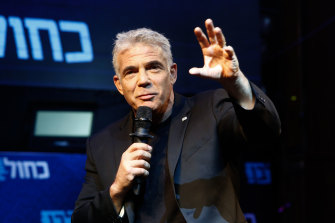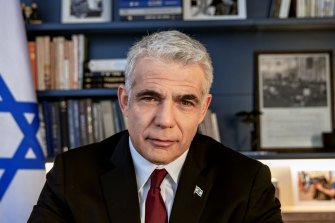Jerusalem: Yair Lapid, the centrist politician and former media celebrity whose party took second place in Israel’s March election, has been picked by the country’s President to try to end a two-year gridlock to form a new government.
Lapid pledged to forgo the prime ministership if that’s what it would take to form a coalition of diverse parties that could oust Prime Minister Benjamin Netanyahu from power.
Yair Lapid has been handed a chance to send Benjamin Netanyahu into opposition.Credit:Bloomberg
The unusual exercise in political humility stemmed not from modesty, but from the difficulties he knew he would face in mustering enough parliamentary support to form an alternative government.
Now, after Netanyahu failed to form a viable coalition by Tuesday’s midnight deadline, Lapid’s political skills and sincerity will be put to the test. President Reuven Rivlin has given him the next shot at cobbling together a government that might send Netanyahu into the opposition.
In a televised address, Rivlin said the former finance minister had the pledged support of 56 of parliament’s 120 members, still short of a majority. He has 28 days to form a coalition.
Lapid’s party, Yesh Atid (There is a Future), won 17 seats in the inconclusive election, Israel’s fourth in two years. But its path to power is hampered by the disparate nature of the anti-Netanyahu bloc, which is made up of numerous small parties with clashing agendas. Some of its right-wing elements view Lapid as too left-wing to lead an alternative government.
An election campaign billboard for Israeli Prime Minister Benjamin Netanyahu (bottom) and opposition candidate Yair Lapid prior to the March 23 election.Credit:Bloomberg
Netanyahu had cast his own campaign as a head-to-head contest against Lapid, dismissing him as a lightweight.
Lapid ran a quiet campaign calling for preserving liberal democracy and thwarting Netanyahu’s stated goal of forming a government made up of right-wing and religious parties, reliant on ultra-Orthodox rabbis and ultra-nationalist extremists.
Lapid has also called to protect the judiciary from Netanyahu, who is standing trial on corruption charges and who, together with his right-wing and religious allies, intended to curb the powers of the Supreme Court and possibly seek some kind of immunity from prosecution.
Yair Lapid Lapid has 28 days to try to form a coalition.Credit:AP
Speaking to party activists before the election, Lapid described the coalition that Netanyahu wanted to form as “an extremist, homophobic, chauvinistic, racist and anti-democratic government,” and said “it’s a government where nobody represents working people, the people who pay taxes and believe in the rule of law”.
As a former finance minister in the Netanyahu-led government formed in 2013, Lapid instituted reforms meant to share the national burden more equally between mainstream Israelis and ultra-Orthodox men who choose full-time Torah study over work and army service, and depend on charity and welfare payouts. Most of his policies were undone by succeeding governments.
In three elections in 2019 and 2020, Lapid’s Yesh Atid ran in a three-party, centrist alliance called Blue and White, led by Benny Gantz, a former army chief of staff. Lapid parted ways with Blue and White after Gantz reneged on a main election promise and joined forces with Netanyahu to form an uneasy — and short-lived — unity government after last year’s election.
After a highly successful career as a journalist and popular television host, Lapid was the surprise of the 2013 election when, as a political novice, his party surpassed expectations and placed second, turning him into the chief power broker in the formation of the coalition.
His father, Yosef Lapid, a Holocaust survivor and an anti-religious politician, once also headed a centrist party and served as justice minister. His mother, Shulamit Lapid, is a well-known novelist.
An amateur boxer known for his casual-chic black clothing, Yair Lapid launched his political career on the back of the social justice protests of 2011, giving voice to the country’s struggling middle class.
On the Israeli-Palestinian conflict, he has stuck to the middle ground, presenting safe positions within the Jewish consensus. He has said that he supports a two-state solution but opposes any division of Jerusalem, which the Palestinians envision as their future capital.
The New York Times
Most Viewed in World
From our partners
Source: Read Full Article





